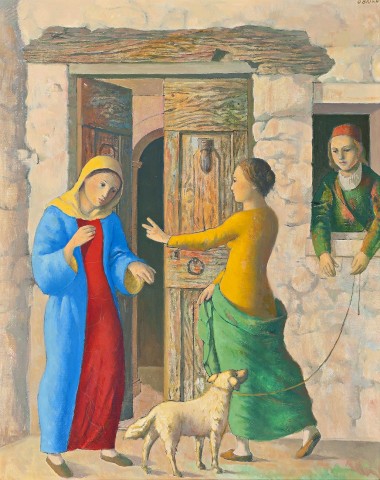THE VISITATION, c.1990 – 93
JUSTIN O’BRIEN
oil on canvas
48.0 x 39.0 cm
signed upper right: O’BRIEN
Australian Galleries, Sydney (label attached verso)
Private collection, Sydney, acquired from the above in 1993
Paintings by Justin O’Brien, Australian Galleries, Sydney, 26 – 31 July 1993; Australian Galleries, Melbourne, 9 August – 4 September 1993,
cat. 7
Pearce, B., and Wilson, N., Justin O'Brien: The Sacred Music of Colour, Art Gallery of New South Wales, Sydney, 2010, pp.144 (illus.), 145 (illus. detail with the artist)
Displaying the intimate connection Justin O’Brien saw between the spiritual and the secular, The Visitation, c.1990 – 93 is a depiction of the most earthly of episodes within the devotional cycle of the Virgin Mary. In a narrative episode only recounted in the Gospel of Luke, Mary travels to Judea to visit her pregnant cousin Elizabeth, to bring her news of her own divine pregnancy. While artistic depictions of this meeting reached their peak in the mid-renaissance, at the height of Marian devotion, they remained less common than images of the Adoration or the Annunciation. O’Brien himself painted this scene several times, particularly in the 1950s and 60s, although often choosing to focus on the landscape, usually Greek or Italian, rather than the intimate exchange between the two female figures held amongst the foreshadowing mountains. Despite suffering through a profound crisis of faith, O’Brien continued to paint religious subjects, seeing within their narrative structures ‘more scope to open up the composition’.1
The Visitation, is a moment of quiet grace and shared personal joy. Painted in an urban setting, the meeting occurring at the doorstep of Elizabeth and Zacharias’ house, assuming O’Brien was literal in his reading of scripture. Mary, dressed in symbolic blue and red garments, appears concerned and afraid, bowing in deference to her older cousin, who gestures to welcome her into her home. O’Brien had an astounding depth of knowledge in art history, particularly in the Flemish and Italian Renaissance, and used his understanding to aliment his compositions. This Visitation bears strong stylistic similarities to Albrecht Dürer’s woodcut of the same scene, from which O’Brien appropriated Zacharias’ figure in the doorway (here at the windowsill) and what is believed to be Dürer’s own dog in the foreground.
O’Brien was able to temper his appetite for hagiography and biblical narrative scenes by integrating his tableaux within larger landscapes and meticulously rendered interiors and still lives. This painting was inspired by a trip to the medieval city of Ronciglione in the Cimini Mountains in Italy, not far from Rome, where O’Brien had lived since 1972.2 Informed by the notebook of sketches he had brought with him on his travels, the Visitation is played out in this atemporal setting, the details of architectural texture faithfully and fastidiously recorded by the artist. O’Brien once spoke of the love he felt within Italian medieval architecture,3 and here a sense of peace and stillness is enforced by his considered recording of these surfaces. The artist sought to achieve a calm permanence in his paintings, presenting them as an antidote to the abrasive freneticism of contemporary life. What sets O’Brien apart in his academicism, however, was his strength as a colourist. Jewel tones pervade the canvas, shining through the brickwork, the wooden panels of the doorframe, Elizabeth’s shadow – imbuing this quiet scene with divine richness.
1. France, C., ‘Tribute. Justin O’Brien’, Art and Australia, Fine Arts Press, Sydney, vol. 33, no. 4, 1996, p. 483
2. Pearce, B., and Wilson, N., Justin O’Brien The Sacred Music of Colour, Art Gallery of New South Wales, Sydney, 2010, p. 144
3. Justin O’Brien in conversation with James Gleeson, 21 September 1978, Canberra, James Gleeson Oral History Collection, National Gallery of Australia, Canberra
LUCIE REEVES-SMITH
